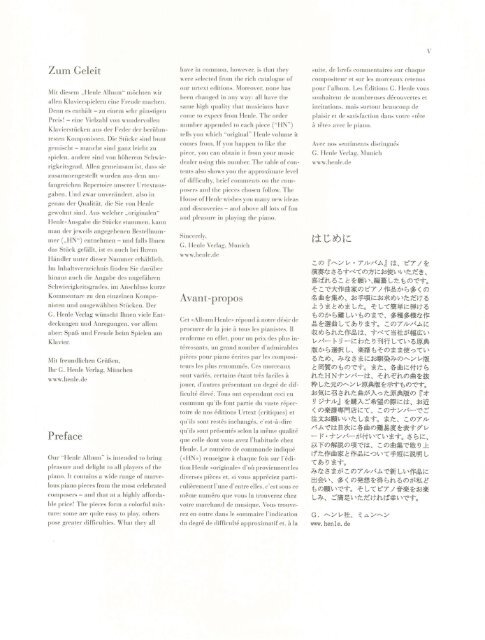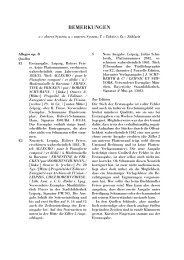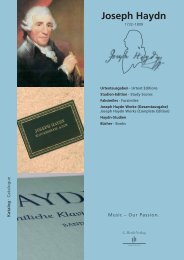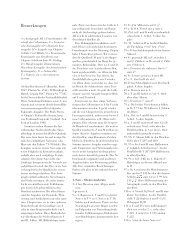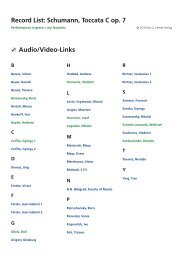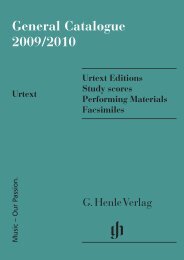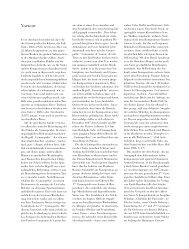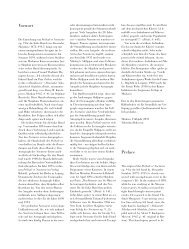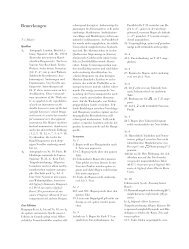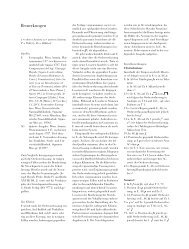Piano Album II Vorwort.fm
Piano Album II Vorwort.fm
Piano Album II Vorwort.fm
You also want an ePaper? Increase the reach of your titles
YUMPU automatically turns print PDFs into web optimized ePapers that Google loves.
VI<br />
Einführung<br />
Nr. 1–2<br />
Johann Sebastian Bach (1685–1750)<br />
komponierte nicht nur zahlreiche Kantaten<br />
und Oratorien, sondern galt auch<br />
als virtuoser Organist und Cembalist.<br />
Die Aria h-moll ist der vierten der Sechs<br />
Partiten entnommen, die der Komponist<br />
im Jahre 1731 als sein erstes Werk stechen<br />
und drucken ließ. Welche Möglichkeiten<br />
auch die selten angewandte<br />
Zweistimmigkeit bietet, zeigt Bach in<br />
der Fuge e-moll aus seinem Wohltemperierten<br />
Klavier Band 1.<br />
Nr. 3<br />
Domenico Scarlatti (1685–1757) gilt<br />
als einer der faszinierendsten Komponisten<br />
der Barockzeit. Er schrieb etwa<br />
550 einsätzige Sonaten, die vom Spieler<br />
„keine Tiefgründigkeit, sondern eher<br />
den geistreichen Spaß“ (<strong>Vorwort</strong> zur<br />
Erstausgabe) in der Spielkunst erwarten.<br />
Mit seinen Sonaten hat Scarlatti die<br />
Musik für Tasteninstrumente sowohl in<br />
spiel- als auch in kompositionstechnischer<br />
Hinsicht entscheidend weiterentwickelt.<br />
Nr. 4–5<br />
Georg Friedrich Händel (1685–1759),<br />
der vor allem durch seine Opern und<br />
Oratorien bekannt ist, komponierte<br />
auch einige Werke für Tasteninstrumente.<br />
Die Sarabande stammt aus dem ersten,<br />
die Courante aus dem zweiten Band<br />
seiner berühmten Suites de Pièces pour<br />
le Clavecin.<br />
Nr. 6<br />
Carl Philipp Emanuel Bach (1714–<br />
1788) war zu seinen Lebzeiten berühmter<br />
als sein Vater Johann Sebastian. In<br />
der 1749 komponierten und 1762/63<br />
erschienenen Sonate C-dur erprobt der<br />
Komponist die Stilmittel der empfindsamen<br />
und vorklassischen Epoche.<br />
Nr. 7–8<br />
Joseph Haydn (1732–1809) begann<br />
erst als Dreißigjähriger, Sonaten zu<br />
schreiben. Sie stehen im Zentrum seines<br />
Klavierschaffens und spiegeln die Entwicklung<br />
des Komponisten bis hin zu<br />
den reifen Spätwerken nach 1780, in<br />
denen auch der Einfluss Mozarts wirksam<br />
wird. Viele seiner Sonaten sind<br />
wertvolle und ansprechende Unterrichtsmusik.<br />
Nr. 9–11<br />
Wolfgang Amadeus Mozarts (1756–<br />
1791) Menuett ist eine der frühesten<br />
Kompositionen aus seiner Feder. Er<br />
schrieb sie als Kind im Übungsbuch für<br />
seine Schwester Nannerl nieder. Der<br />
vermutlich 1784 komponierte, ironische<br />
Trauermarsch des Signor Maestro Contrapunto<br />
stammt aus dem Stammbuch<br />
der ausgezeichneten Pianistin Barbara<br />
Ployer. Sie erhielt von Mozart Theorieunterricht<br />
und für sie entstand unter<br />
anderem sein Klavierkonzert in G-dur<br />
KV 453. Das Andante cantabile gehört<br />
zur ersten Sonate aus einer Gruppe von<br />
drei Werken dieser Gattung (KV 330–<br />
332), die wahrscheinlich 1783, also um<br />
dieselbe Zeit wie der Trauermarsch,<br />
entstand.<br />
Nr. 12–14<br />
Ludwig van Beethoven (1770–1827)<br />
komponierte die Sonate E-dur op. 14<br />
Nr. 1, aus der das Allegretto entnommen<br />
ist, 1798 oder 1799. Über die wenige<br />
Jahre später entstandene Bearbeitung<br />
für Streichquartett schrieb er: „das<br />
macht mir nicht so leicht ein andrer<br />
nach“. Immer noch wird viel darüber<br />
diskutiert, ob er das Werk sogar ursprünglich<br />
für Streichquartett und nicht<br />
für Klavier skizzierte. Der Text des<br />
Schweizer Liedes, auf das Beethoven<br />
noch in seiner Bonner Zeit vor der Übersiedelung<br />
nach Wien seinen kurzen Variationenzyklus<br />
schrieb, lautet: „Es hätt’<br />
e’ Buur e’ Töchterli, mit Name heißt es<br />
Babeli, sie hätt’ e paar Zöpfli, sie sind<br />
wie Gold, drum ist ihm auch der Dusle<br />
hold“. Die mit Bagatellen bezeichneten,<br />
meist kürzeren Stücke sind keineswegs<br />
immer, wie ihr Name vielleicht vermuten<br />
lässt, „Kleinigkeiten“. Beethoven<br />
nutzte sie vielmehr häufig zu Formund<br />
Ausdrucksexperimenten auf hohem<br />
Niveau.<br />
Nr. 15<br />
Carl Maria von Weber (1786–1826)<br />
komponierte die Sonate C-dur im Jahre<br />
1812. Weber, der selbst einer der bedeutendsten<br />
und virtuosesten Klavierspieler<br />
seiner Zeit war, wusste in seinen vier<br />
großen Sonaten geschickt brillante<br />
Spieltechnik mit eingängiger Melodik<br />
zu verbinden.<br />
Nr. 16–18<br />
Franz Schuberts (1797–1828) Moments<br />
Musicaux entstanden in den Jahren<br />
1823–1828. Sie sind, wie auch die<br />
Impromptus, lyrische einsätzige Klavierstücke.<br />
Aus dem Jahr 1817 stammt die<br />
Sonate D 568 in Es-dur, die jedoch erst<br />
nach Schuberts Tod veröffentlicht wurde.<br />
Die Variation über einen Walzer von<br />
Anton Diabelli vom März 1821 entstand,<br />
wie Beethovens großer Variationenzyklus<br />
op. 120, im Rahmen eines<br />
von Diabelli selbst ausgeschriebenen<br />
„Komponistenwettbewerbs“.<br />
Nr. 19–20<br />
Felix Mendelssohn Bartholdy (1809–<br />
1847) beherrschte nicht nur die großen<br />
Formen der Symphonik und Kammermusik,<br />
sondern war auch ein Meister<br />
des kleinen Klavierstücks. Die Kinderstücke<br />
op. 72 wurden erst nach dem Tod<br />
des Komponisten aus dem Nachlass mit<br />
dem Zusatz „Christmas Present for his<br />
Young Friends“ in England veröffentlicht,<br />
das Autograph der Nummer zwei<br />
datiert vom 21. Juni 1842. Die Lieder<br />
ohne Worte waren bereits zu Mendelssohn<br />
Bartholdys Lebzeiten ein beispielloser<br />
Publikumserfolg. Opus 19 erschien<br />
1832 als erste Sammlung, der noch viele<br />
folgen sollten.<br />
Nr. 21–23<br />
Frédéric Chopin (1810–1849) widmete<br />
sein kompositorisches Schaffen nahezu<br />
ausschließlich dem Klavier. Viele seiner<br />
Werke wenden sich an den versierten<br />
Klavieramateur des bürgerlichen<br />
Salons. Die 24 Préludes op. 28, erschienen<br />
1839, durchmessen in großer formaler<br />
Vielfalt alle 24 Dur- und Molltonarten.<br />
Die Nocturne c-moll, komponiert<br />
1837, war von Chopin nicht zur Veröf-
fentlichung vorgesehen und erschien<br />
erstmals 1938. Auch die bereits in der<br />
Jugendzeit 1827 komponierte Mazurka<br />
a-moll op. 68, 2 wurde postum 1855 gedruckt,<br />
gehört aber zu den erfolgreichsten<br />
Stücken dieses Genres.<br />
Nr. 24–26<br />
Robert Schumann (1810–1856) komponierte<br />
die Waldszenen op. 82 um die<br />
Jahreswende 1848/49. Diese romantischen<br />
Klavierstücke waren bereits nach<br />
ihrem Erscheinen sehr beliebt und sprachen<br />
das allgemeine poetische Empfinden<br />
der damaligen Zeit an. Im selben<br />
Jahr, im September 1848, schrieb er<br />
auch das Klavieralbum für die Jugend,<br />
einfache und sehr hübsche Stücke, die<br />
gut für den Anfänger geeignet sind.<br />
1853 stellte Schumann die <strong>Album</strong>blätter<br />
op. 124 zusammen. Sie bilden eine<br />
Nachlese aus den Jahren 1832–1845<br />
und sind ebenfalls reizvolle Stücke für<br />
den Unterricht.<br />
Nr. 27–28<br />
Franz Liszt (1811–1886) hielt 1837/<br />
38 seine Eindrücke eines ausgedehnten<br />
Aufenthalts in der Schweiz im Kompositionszyklus<br />
<strong>Album</strong> d’un voyageur fest.<br />
Das ursprünglich unter dem Titel Fleurs<br />
mélodiques des Alpes veröffentlichte<br />
Stück arbeitete er über zehn Jahre später<br />
für den Zyklus Années de Pélerinage<br />
um und nannte es nun Le mal du pays<br />
(Heimweh). Es basiert auf einem Appenzeller<br />
Kuhreigen. Die Entstehung<br />
und der Titelbezug von Liszts beliebten<br />
Consolations (Tröstungen) liegt<br />
dagegen weitgehend im Dunkeln. Die<br />
Stücke entstanden in den 40er Jahren<br />
des 19. Jahrhunderts.<br />
Nr. 29<br />
Clara Wieck-Schumann (1819–<br />
1896) komponierte die Charakterstücke<br />
op. 5 in den Jahren 1834–1836, noch<br />
vor ihrer Heirat mit Robert Schumann.<br />
Opus 5 und 6 erschienen gemeinsam im<br />
Jahr 1836 in Leipzig. Zwei Jahre später<br />
hatte der Verleger Ho<strong>fm</strong>eister diese beiden<br />
Werke übernommen und legte sie<br />
unter dem Titel Soirées musicales / 10<br />
Pièces caractéristiques vor.<br />
Nr. 30<br />
Theodor Kirchners (1823–1903) Klaviermusik<br />
wurde von seinen Zeitgenossen<br />
sehr geschätzt. Von Mendelssohn<br />
gefördert, von Schumann begeistert<br />
empfohlen, fand Kirchner in Johannes<br />
Brahms einen langjährigen Mentor und<br />
Freund. Die <strong>Album</strong>blätter op. 7 erschienen<br />
im Mai 1856. In ihnen zeigen sich<br />
bereits harmonische Kühnheiten, die<br />
Kirchner in seinen späteren Kompositionen<br />
noch weiterentwickelte.<br />
Nr. 31–32<br />
Johannes Brahms (1833–1897)<br />
schrieb 1866 zu den Entstehungsumständen<br />
der Walzer op. 39 an den Widmungsträger<br />
Eduard Hanslick: „Ich<br />
dachte an Wien, an die schönen Mädchen,<br />
mit denen Du vierhändig spielst,<br />
an Dich selbst, den Liebhaber von derlei,<br />
den guten Freund“. Brahms’ Intermezzi<br />
sind, entgegen der eigentlichen<br />
Bedeutung des Titels, keine wirklichen<br />
Zwischenspiele, sondern tiefgründige,<br />
meist melancholisch gefärbte eigenständige<br />
Stücke. So eröffnet das 1893 komponierte<br />
Intermezzo Nr. 1 aus op. 118<br />
die Folge von sechs Stücken, von denen<br />
vier diesen Titel tragen.<br />
Nr. 33<br />
Peter Iljitsch Tschaikowsky (1840–<br />
1893) schrieb die Sechs Stücke für Klavier<br />
op. 19 im Jahr 1873. Er widmete<br />
sie ihm bekannten Pianisten und berücksichtigte<br />
beim Komponieren deren<br />
pianistische Fähigkeiten. So entstanden<br />
facettenreiche, dankbare Stücke, die in<br />
ihrer Art auch auf Tschaikowskys Beschäftigung<br />
mit Schumanns Werken<br />
hinweisen.<br />
Nr. 34<br />
Antonín Dvorák (1841–1904) vollendete<br />
die Komposition seines größten Zyklus<br />
für Klavier zu zwei Händen im Juni<br />
1889. Die Poetischen Stimmungsbilder<br />
op. 85 enthalten einige der schönsten<br />
Klaviersätze, die Dvorák für Klavier<br />
zu zwei Händen schrieb.<br />
V<strong>II</strong><br />
Nr. 35<br />
Edvard Grieg (1843–1907) bearbeitete<br />
norwegische Bauerntänze – die sogenannten<br />
Slåtter – für Klavier, die 1903<br />
als Sammlung in Leipzig erschienen.<br />
Diese eigentlich für Geige (Hardangergeige)<br />
tradierten Stücke wurden eigens<br />
hierfür aufgezeichnet. Bei der Übertragung<br />
auf das Klavier versuchte Grieg,<br />
die „stilisierte Harmonik dieser Volkstöne<br />
auf ein künstlerisches Niveau zu<br />
erheben“ (Griegs eigenes <strong>Vorwort</strong> in<br />
der Erstausgabe).<br />
Nr. 36–37<br />
Claude Debussy (1862–1918) legte<br />
1910 das erste Heft mit 12 Préludes vor<br />
– daraus in unsrer Sammlung die Nr. 6<br />
Des pas sur la neige (Schritte im<br />
Schnee) –, 1913 folgte Heft zwei mit<br />
weiteren 12 Stücken. Morceau de concours<br />
erschien 1905 als eine von sechs<br />
anonym abgedruckten Kompositionen<br />
in der Musikbeilage der Pariser Zeitschrift<br />
Musica, deren Leser die Komponisten<br />
erraten sollten. Neben Debussy<br />
befanden sich unter anderem Massenet<br />
und Saint-Saëns darunter.<br />
Nr. 38<br />
Alexander Skrjabin (1872–1915)<br />
wollte ursprünglich einen Zyklus von 48<br />
Préludes komponieren, in welchem jede<br />
Dur- und Molltonart je zweimal vorkommen<br />
sollte. Kurz vor Drucklegung<br />
distanzierte er sich von diesem Plan und<br />
teilte die Stücke auf mehrere Hefte auf.<br />
Das 1897 veröffentlichte Opus 11 folgt<br />
der strengen Anordnung nach dem<br />
Quintenzirkel. Anklänge an Chopins<br />
Prélude-Zyklen sind unverkennbar.<br />
Nr. 39<br />
Max Regers (1873–1916) Sammlung<br />
Blätter und Blüten wurde 1910 für die<br />
Veröffentlichung bei Breitkopf & Härtel<br />
aus älteren Kompositionen zusammengestellt.<br />
Fast alle dieser kleinen, nicht<br />
allzu schweren Klavierstücke sind in<br />
den Jahren 1900–1902 als Musik-Beilagen<br />
in der Neuen Musik-Zeitung erschienen.
V<strong>II</strong>I<br />
Introduction<br />
No. 1–2<br />
Johann Sebastian Bach (1685–1750)<br />
was not only a prolific composer of cantatas<br />
and oratorios but also a virtuoso<br />
organist and harpsichord player. The<br />
Aria in B minor comes from the fourth<br />
of his Six Partitas, the first work that<br />
Bach allowed to be engraved and issued<br />
in print (1731). The possibilities latent<br />
in the rarely used two-voice contrapuntal<br />
texture are evident in the Fugue in E<br />
minor, taken from Book 1 of the Well-<br />
Tempered Clavier.<br />
No. 3<br />
Domenico Scarlatti (1685–1757) was<br />
one of the most fascinating composers of<br />
the Baroque. He wrote some 550 singlemovement<br />
sonatas which, to quote the<br />
preface to the first edition, require from<br />
the player “not profundity so much as<br />
frolicsome ingenuity.” Scarlatti’s sonatas<br />
had a decisive and lasting impact on<br />
both the performance and the compositional<br />
technique of keyboard music.<br />
No. 4–5<br />
George Frideric Handel (1685–1759)<br />
is best known for his operas and oratorios,<br />
but he also wrote several works for<br />
keyboard instruments. The Sarabande<br />
comes from Volume 1 of his famous<br />
Suites de Pièces pour le Clavecin, the<br />
Courante from Volume 2.<br />
No. 6<br />
Carl Philipp Emanuel Bach (1714–<br />
1788) was more famous during his lifetime<br />
than his father Johann Sebastian.<br />
The Sonata in C major, composed in<br />
1749 and published in 1762–3, probes<br />
the stylistic devices of the pre-classical<br />
period and the Age of Sensitivity.<br />
No. 7–8<br />
Joseph Haydn (1732–1809) only began<br />
to write sonatas from the age of<br />
thirty. They form the core of his keyboard<br />
music, reflecting his evolution all<br />
the way to the post-1780 works of his<br />
late maturity, by which time the influence<br />
of Mozart can be felt. Many of<br />
Haydn’s sonatas have become useful<br />
and appealing staples of the teaching<br />
repertoire.<br />
No. 9–11<br />
Wolfgang Amadeus Mozart (1756–<br />
1791) wrote down the Minuet in his sister<br />
Nannerl’s practice book in his early<br />
childhood; indeed, it is one of his earliest<br />
works altogether. The mock funeral<br />
march Trauermarsch des Signor Maestro<br />
Contrapunto was probably composed<br />
in 1784. It is taken from the<br />
album of Barbara Ployer, an excellent<br />
pianist who studied composition with<br />
Mozart. Among the other works Mozart<br />
wrote for her is the <strong>Piano</strong> Concerto in G<br />
major, K. 453. The Andante cantabile<br />
comes from the first of a set of three<br />
sonatas, K. 330–332, which were probably<br />
written in 1783 and hence at the<br />
same time as the funeral march.<br />
No. 12–14<br />
Ludwig van Beethoven (1770–1827)<br />
wrote his Sonata in E major (op. 14<br />
no. 1), and hence the Allegretto taken<br />
from it, in 1798 or 1799. A few years<br />
later he arranged the piece for string<br />
quartet, adding that “you will hardly<br />
find a musician capable of bringing it<br />
off as I have done.” Indeed, scholars still<br />
debate whether the piece was originally<br />
sketched for string quartet or for piano.<br />
Beethoven wrote his Variations on a<br />
Swiss Song during his Bonn years shortly<br />
before setting out for Vienna. The<br />
words, in Swiss dialect, translate roughly<br />
as “A farmer has a daughter, her<br />
name is Babeli, she has a pair of braids<br />
like gold, that’s why the maid’s so dear<br />
to him.” Not all of the generally short<br />
pieces known as Bagatelles are as insignificant<br />
as their name implies. On the<br />
contrary, Beethoven often used them for<br />
experiments in form and expression on a<br />
high level.<br />
No. 15<br />
Carl Maria von Weber (1786–1826)<br />
wrote his Sonata in C major in 1812.<br />
One of the leading and most accom-<br />
plished pianists of his age, Weber composed<br />
four large-scale sonatas that deftly<br />
combine brilliant technique with ingratiating<br />
melodies.<br />
No. 16–18<br />
Franz Schubert (1797–1828) wrote<br />
the Moments Musicaux from 1823 to<br />
1828. Like the Impromptus, they are<br />
lyric piano pieces in a single movement.<br />
The Sonata in E-flat major (D 568) was<br />
composed in 1817 but not published<br />
until after Schubert’s death. The Variation<br />
on a Waltz by Anton Diabelli was<br />
written in March 1821. Like Beethoven’s<br />
great set of variations on the same<br />
theme (op. 120), it was written for a<br />
“composers’ competition” sponsored by<br />
Diabelli himself.<br />
No. 19–20<br />
Felix Mendelssohn Bartholdy (1809–<br />
1847) not only had a perfect command<br />
of large-scale symphonic and chamber<br />
music but was also a master of the short<br />
piano piece. The Christmas Pieces op. 72<br />
were published in England after the<br />
composer’s death, with the title expanded<br />
to read “Christmas Present for his<br />
Young Friends.” The autograph manuscript<br />
of piece no. 2 is dated 21 June<br />
1842. The Songs without Words were<br />
hugely popular even during Mendelssohn’s<br />
lifetime. Opus 19, published in<br />
1832, was the first in a long series of<br />
such collections.<br />
No. 21–23<br />
Frédéric Chopin (1810–1849) devoted<br />
his creative work almost exclusively<br />
to the piano. Much of his music is aimed<br />
at the accomplished amateur pianist of<br />
the middle-class drawing room. Published<br />
in 1839, the Twenty-Four Préludes<br />
op. 28 traverse all twenty-four<br />
major and minor keys in a great variety<br />
of forms. The Nocturne in C minor,<br />
written in 1837, was not originally intended<br />
for publication and appeared in<br />
print for the first time in 1938. The Mazurka<br />
in A minor (op. 68, no. 2), written<br />
in Chopin’s youth in 1827, is one of the<br />
most successful pieces in its genre. It too<br />
appeared posthumously, in 1855.
No. 24–26<br />
Robert Schumann (1810–1856) composed<br />
the Forest Scenes op. 82 at the<br />
end of 1848 and the beginning of 1849.<br />
These romantic piano pieces captured<br />
the poetic sensibilities of their age and<br />
became very popular shortly after their<br />
publication. In the same year, in September<br />
1848, Schumann also wrote the<br />
<strong>Album</strong> for the Young, a collection of simple<br />
yet very pretty pieces well-suited for<br />
beginners. The <strong>Album</strong> Leaves op. 124, a<br />
selection of pieces dating from 1832 to<br />
1845 and gathered together in 1853, are<br />
likewise delightful for teaching purposes.<br />
No. 27–28<br />
Franz Liszt (1811–1886) put down his<br />
impressions of a lengthy stay in Switzerland<br />
in a cycle of piano pieces, <strong>Album</strong><br />
d’un voyageur (1837–8). Our piece was<br />
originally entitled Fleurs mélodiques des<br />
Alpes. Ten years later Liszt reworked it<br />
for his cycle Années de Pélerinage, at<br />
which time he gave it a new title, Le mal<br />
du pays (“Homesickness”). It is based<br />
on a shepherd’s tune from the Appenzell<br />
region. In contrast, the origins of Liszt’s<br />
popular Consolations are largely<br />
shrouded in obscurity, as is the meaning<br />
of their title. The pieces originated during<br />
the 1840s.<br />
No. 29<br />
Clara Wieck-Schumann (1819–1896)<br />
wrote her Character Pieces op. 5 in<br />
1834–6 before her marriage to Robert<br />
Schumann. Opp. 5 and 6 were published<br />
jointly in Leipzig in 1836. Two<br />
years later the publisher Ho<strong>fm</strong>eister acquired<br />
the two works and reissued them<br />
as Soirées musicales / 10 Pièces caractéristiques.<br />
No. 30<br />
Theodor Kirchner (1823–1903) was a<br />
composer of piano music highly esteemed<br />
by his contemporaries. Promoted<br />
by Mendelssohn and championed by<br />
Schumann, he eventually found a lifelong<br />
mentor and friend in Johannes<br />
Brahms. The <strong>Album</strong> Leaves op. 7, published<br />
in May 1856, already reveal the<br />
bold harmonies that he would further<br />
pursue in his later works.<br />
No. 31–32<br />
Johannes Brahms (1833–1897) dedicated<br />
his Waltzes op. 39 to Eduard<br />
Hanslick, to whom he wrote in 1866: “I<br />
thought of Vienna, of all the pretty girls<br />
with whom you play piano duets, and of<br />
yourself, the lover of such things and my<br />
good friend.” His Intermezzi, despite the<br />
connotations of their title, are not really<br />
musical interludes but deeply felt pieces<br />
in their own right, usually of a melancholy<br />
tinge. The Intermezzo op. 118<br />
no. 1, composed in 1893, opens a set<br />
of six pieces of which four bear the title<br />
Intermezzo.<br />
No. 33<br />
Pyotr Il’yich Tchaikovsky (1840–1893)<br />
wrote his Six <strong>Piano</strong> Pieces op. 19 in 1873.<br />
They are dedicated to pianists of his acquaintance<br />
and take their pianistic skills<br />
into account. The result is a set of manyfacetted<br />
and ingratiating pieces, each of<br />
which, in its own way, reflects the composer’s<br />
study of Schumann.<br />
No. 34<br />
Antonín Dvorák (1841–1904) completed<br />
his great piano cycle in June<br />
1889. The Poetic Moods op. 85 contain<br />
some of the most beautiful pieces he<br />
ever wrote for piano two-hands.<br />
No. 35<br />
Edvard Grieg (1843–1907) arranged<br />
Norwegian peasant dances – the socalled<br />
Slåtter – for piano and had the<br />
collection published in Leipzig in 1903.<br />
These folk pieces, actually handed down<br />
for hardanger fiddle, were specially<br />
transcribed for the composer’s use. In<br />
transferring them to the piano Grieg, as<br />
he wrote in his preface to the first edition,<br />
attempted to “elevate the stylized<br />
harmonies of these folk tunes to the<br />
level of art.”<br />
No. 36–37<br />
Claude Debussy (1862–1918) produced<br />
his first volume of twelve<br />
IX<br />
Préludes in 1910. We have selected<br />
piece no. 6, Des pas sur la neige (Footsteps<br />
in the Snow). A second volume of<br />
twelve Préludes followed in 1913.<br />
Morceau de concours was one of six<br />
compositions published anonymously in<br />
a musical supplement to the Parisian<br />
magazine Musica in 1905. Readers were<br />
invited to guess the names of the composers,<br />
among whom were also Massenet<br />
and Saint-Saëns.<br />
No. 38<br />
Aleksandr Skryabin (1872–1915)<br />
originally wanted to write a cycle of forty-eight<br />
préludes in which each major<br />
and minor key occurs twice. Shortly before<br />
the work’s publication, however, he<br />
abandoned this plan and divided the<br />
pieces among several volumes. Opus 11,<br />
published in 1897, is organized strictly<br />
in accordance with the circle of fifths.<br />
Allusions to Chopin’s Préludes are unmistakable.<br />
No. 39<br />
Max Reger (1873–1916) compiled his<br />
Blätter und Blüten (Leaves and Blossoms)<br />
in 1910 from earlier pieces in order<br />
to have them published by Breitkopf<br />
& Härtel. Almost all these short and not<br />
overly difficult piano pieces had already<br />
appeared as musical supplements to the<br />
Neue Musik-Zeitung in 1900–02.<br />
Introduction<br />
Nos 1–2<br />
Jean-Sébastien Bach (1685–1750) a<br />
non seulement composé de nombreux<br />
oratorios et cantates mais il était aussi<br />
virtuose de l’orgue et du clavecin. L’Aria<br />
en si mineur est extrait de la quatrième<br />
des Six Partitas, la première œuvre que,<br />
en 1731, le compositeur fit graver et publier.<br />
Bach montre dans sa Fugue en mi<br />
mineur, tirée du Clavecin bien tempéré,<br />
livre 1, les possibilités offertes aussi par<br />
la fugue à deux voix, pourtant rarement<br />
utilisée.
X<br />
No 3<br />
Domenico Scarlatti (1685–1757) est<br />
l’un des compositeurs les plus fascinants<br />
de l’époque baroque. Il a écrit quelque<br />
550 sonates à un mouvement, ne réclamant<br />
de la part de l’exécutant «aucune<br />
profondeur mais plutôt le divertissement<br />
spirituel» (préface de l’édition originale)<br />
à l’interprétation. Avec ses sonates,<br />
Scarlatti a fait progresser de façon<br />
décisive la musique des instruments à<br />
clavier, tant du point de vue de la technique<br />
instrumentale que sur le plan de<br />
l’écriture.<br />
Nos 4–5<br />
Georg Friedrich Haendel (1685–<br />
1759), connu avant tout pour ses opéras<br />
et ses oratorios, a aussi écrit quelques<br />
œuvres pour instruments à clavier. La<br />
Sarabande provient du premier, la Courante<br />
du second recueil de ses fameuses<br />
Suites de Pièces pour le Clavecin.<br />
No 6<br />
Carl Philipp Emanuel Bach (1714–<br />
1788) était plus connu de son vivant<br />
que son père, Jean-Sébastien. Dans la<br />
Sonate en Ut majeur, composée en 1749<br />
et publiée en 1762/63, le compositeur se<br />
consacre aux moyens stylistiques d’une<br />
époque préclassique, riche de sensibilité.<br />
Nos 7–8<br />
Joseph Haydn (1732–1809) avait<br />
trente ans passés quand il a commencé<br />
à composer des sonates. Celles-ci se situent<br />
au centre de son œuvre pianistique<br />
et reflètent l’évolution du compositeur<br />
jusqu’aux compositions de la maturité<br />
écrites après 1780, dans lesquelles apparaît<br />
déjà l’influence de Mozart. Nombre<br />
de ses sonates constituent pour l’enseignement<br />
un répertoire précieux de compositions<br />
on ne peut plus attrayantes.<br />
Nos 9–11<br />
Wolfgang Amadeus Mozart (1756–<br />
1791): le Menuet est l’une de ses premières<br />
compositions; le jeune Wolfgang<br />
Amadeus l’avait noté dans le livre<br />
d’exercices à l’intention de sa sœur Nannerl.<br />
La Marche funèbre du Sieur Maestro<br />
Contrapunto, œuvre ironique écrite<br />
probablement en 1784, fait partie de<br />
l’album de l’excellente pianiste Barbara<br />
Ployer. Celle-ci avait reçu de Mozart un<br />
enseignement théorique et c’est pour<br />
elle qu’il avait composé entre autres<br />
son Concerto pour piano en Sol majeur<br />
K. 453. L’Andante cantabile se rattache<br />
à la première sonate d’une série de<br />
trois compositions de ce même genre<br />
(K. 330–332), probablement écrites<br />
en 1783, donc à peu près au même<br />
moment que la Marche funèbre.<br />
Nos 12–14<br />
Ludwig van Beethoven (1770–1827)<br />
a composé en 1798 ou 1799 la Sonate<br />
en Mi majeur op. 14, No 1 dont est extrait<br />
l’Allegretto. À propos de l’arrangement<br />
pour quatuor à cordes composé<br />
quelques années plus tard, le compositeur<br />
écrit: «il ne sera pas si facile pour<br />
un autre d’en faire autant». On discute<br />
toujours beaucoup sur le fait de savoir<br />
s’il a même esquissé initialement l’œuvre<br />
pour quatuor à cordes et non pour le<br />
piano. Le texte du chant suisse sur lequel<br />
Beethoven, alors encore à Bonn,<br />
à la veille d’aller s’établir à Vienne, a<br />
composé son bref cycle de variations est<br />
le suivant: «Es hätt’ e’ Buur e’ Töchterli,<br />
mit Name heißt es Babeli, sie hätt’ e<br />
paar Zöpfli, sie sind wie Gold, drum ist<br />
ihm auch der Dusle hold» (il était un<br />
paysan qui avait une fille; de son nom<br />
elle s’appelait Babeli, elle portait des<br />
nattes toutes dorées et voilà pourquoi<br />
Dusle lui faisait les yeux doux». Les pièces,<br />
plutôt courtes pour la plupart, désignées<br />
sous le nom de Bagatelles ne sont<br />
en aucun cas toujours, comme leur désignation<br />
pourrait le laisser supposer, des<br />
compositions insignifiantes. Bien au<br />
contraire, Beethoven les utilise souvent,<br />
à un niveau élevé, pour des expériences<br />
touchant la forme et l’expression.<br />
N o 15<br />
Carl Maria von Weber (1786–1826) a<br />
composé sa Sonate en Ut majeur en<br />
1812. Weber, lui-même l’un des pianistes<br />
les plus importants et l’un des plus<br />
grands virtuoses de son temps, a su allier<br />
avec habileté dans ses quatre grandes<br />
sonates une technique instrumentale<br />
brillante à un agencement mélodique<br />
simple.<br />
Nos 16–18<br />
Franz Schubert (1797–1828) a composé<br />
dans les années 1823–1828 ses<br />
Moments musicaux. Il s’agit, comme les<br />
Impromptus, de pièces pour piano lyriques<br />
en un mouvement. La Sonate D<br />
568 en Mi bémol majeur date de l’année<br />
1817 mais ne sera publiée qu’après la<br />
mort de Schubert. La Variation über einen<br />
Walzer von Anton Diabelli (Variation<br />
sur une valse d’Anton Diabelli),<br />
datant de mars 1821, a été composée,<br />
comme le grand cycle de variations<br />
op. 120 de Beethoven, dans le cadre<br />
d’un «concours de compositeurs» organisé<br />
par Diabelli lui-même.<br />
Nos 19–20<br />
Felix Mendelssohn Bartholdy (1809–<br />
1847) possédait non seulement les grandes<br />
formes de la symphonie et de la musique<br />
de chambre, mais il était en outre<br />
un maître de la petite pièce pour piano.<br />
Les Kinderstücke op. 72, faisant partie<br />
de la succession du compositeur, furent<br />
publiés après sa mort seulement, en Angleterre,<br />
accompagnés de la mention<br />
«Christmas Present for his Young<br />
Friends», l’autographe de la pièce No 2<br />
étant daté du 21 juin 1842. Les Romances<br />
sans paroles rencontrèrent du vivant<br />
même de Mendelssohn un succès sans<br />
précédent. L’opus 19 fut édité en 1832;<br />
il s’agissait d’un premier recueil de pièces,<br />
auquel nombre d’autres allaient<br />
s’ajouter.<br />
Nos 21–23<br />
Frédéric Chopin (1810–1849) a consacré<br />
son œuvre presque exclusivement<br />
au piano. Nombre de ses compositions<br />
s’adressaient au pianiste amateur exercé<br />
du salon bourgeois. Les 24 Préludes<br />
op. 28, publiés en 1839, parcourent,<br />
selon une grande diversité formelle,<br />
l’ensemble des 24 tonalités majeures et<br />
mineures. Le Nocturne en ut mineur,<br />
composé en 1837, n’était pas destiné<br />
initialement par Chopin à la publication<br />
et la première édition date de 1938 seulement.<br />
De même, la Mazurka en la mi-
neur op. 68, 2, œuvre de jeunesse du<br />
compositeur écrite en 1827, est publiée<br />
à titre posthume en 1855 mais elle<br />
compte parmi les compositions les plus<br />
appréciées du genre.<br />
N os 24–26<br />
Robert Schumann (1810–1856) a<br />
composé ses Waldszenen op. 82 (Scènes<br />
de la forêt) à la fin de l’année 1848. Ces<br />
pièces romantiques, très populaires dès<br />
leur publication, répondaient à la sensibilité<br />
poétique générale de l’époque. La<br />
même année, en septembre 1848, Schumann<br />
avait aussi écrit l’<strong>Album</strong> pour la<br />
jeunesse, recueil de pièces simples, très<br />
jolies, particulièrement adaptées au débutant.<br />
En 1853, le compositeur a rassemblé<br />
les <strong>Album</strong>blätter op. 124, un<br />
recueil de pièces écrites entre 1832 et<br />
1845, elles aussi très attrayantes pour<br />
l’enseignement.<br />
N os 27–28<br />
Franz Liszt (1811–1886) retint en<br />
1837/38 dans un cycle intitulé <strong>Album</strong><br />
d’un voyageur les impressions réunies<br />
au cours de son séjour prolongé en<br />
Suisse. Le compositeur a retravaillé plus<br />
de dix ans après pour son cycle Années<br />
de pèlerinage la pièce initialement publiée<br />
sous le titre Fleurs mélodiques des<br />
Alpes, l’intitulant cette fois Le mal du<br />
pays. La pièce en question se base sur<br />
un «ranz des vaches», une chanson<br />
pastorale suisse originaire du canton<br />
d’Appenzell. Par contre, la genèse et la<br />
référence des Consolations si chères à<br />
Liszt sont restées en grande partie inconnues.<br />
Ces pièces pour piano datent<br />
des années 40 du dix-neuvième siècle.<br />
N o 29<br />
Clara Wieck-Schumann (1819–1896)<br />
a composé ses Charakterstücke op. 5<br />
dans les années 1834–1836, avant son<br />
mariage avec Robert Schumann. Les<br />
opus 5 et 6 furent publiés en même<br />
temps à Leipzig, en 1836. Deux ans plus<br />
tard, l’éditeur Ho<strong>fm</strong>eister a repris les<br />
deux œuvres et les a publiées sous le<br />
titre Soirées musicales / 10 Pièces caractéristiques.<br />
No 30<br />
Theodor Kirchner (1823–1903): sa<br />
musique de piano fut très appréciée de<br />
ses contemporains. Encouragé par Mendelssohn,<br />
conseillé avec enthousiasme<br />
par Schumann, Kirchner a trouvé en la<br />
personne de Johannes Brahms un mentor<br />
et ami fidèle. Les <strong>Album</strong>blätter op. 7<br />
sont parues en mai 1856. On y découvre<br />
déjà certaines hardiesses harmoniques<br />
que Kirchner développera encore dans<br />
ses compositions ultérieures.<br />
N os 31–32<br />
Johannes Brahms (1833–1897) écrivit<br />
en 1866 à Eduard Hanslick, le dédicataire,<br />
au sujet des circonstances relatives<br />
à la genèse de ses Walzer op. 39 (Valses<br />
pour piano): «J’ai pensé à Vienne, aux<br />
jolies jeunes filles avec lesquelles tu<br />
joues à quatre mains, à toi-même, leur<br />
amoureux, à mon cher ami». Contrairement<br />
à la signification propre du titre,<br />
les Intermezzi de Brahms ne représentent<br />
pas de véritables intermezzos, des<br />
intermèdes musicaux, mais des pièces<br />
profondes à part entière, le plus souvent<br />
teintées de mélancolie. C’est ainsi que<br />
l’Intermezzo N o 1 composé en 1893,<br />
faisant partie de l’op. 118, ouvre la série<br />
de six pièces, dont quatre portent ce<br />
même titre.<br />
No 33<br />
Piotr Ilitch Tchaïkovski (1840–1893)<br />
a écrit ses Six Pièces pour piano op. 19<br />
en 1873. Les dédiant à des pianistes<br />
qu’il connaissait, il a tenu compte à la<br />
composition de leurs aptitudes pianistiques.<br />
C’est ainsi que sont nées des pièces<br />
aux multiples facettes, agréables à jouer,<br />
renvoyant aussi dans leur manière à<br />
l’intérêt porté par le compositeur aux<br />
œuvres de Schumann.<br />
N o 34<br />
Antonin Dvorák a achevé en juin 1889<br />
la composition de son plus grand cycle<br />
pour piano à deux mains. Les Poetische<br />
Stimmungsbilder op. 85 (Impressions<br />
poétiques) renferment quelques-unes de<br />
plus belles pièces que Dvorák ait écrites<br />
pour piano à deux mains.<br />
XI<br />
No 35<br />
Edvard Grieg (1843–1907) a arrangé<br />
pour le piano des danses paysannes norvégiennes<br />
– les Slåtter (Danses paysannes)<br />
–, publiées en 1903, sous forme de<br />
recueil, à Leipzig. Ces pièces, destinées<br />
en réalité au violon (violon du Hardanger),<br />
avaient été spécialement notées à<br />
cette fin pour le compositeur. En les<br />
transcrivant pour le piano, Grieg a essayé<br />
comme il le dit lui-même d’«élever<br />
à un niveau artistique l’harmonie stylisée<br />
de ces sonorités populaires» (préface<br />
rédigée par Grieg pour la première édition).<br />
Nos 36–37<br />
Claude Debussy (1862–1918) a publié<br />
en 1910 le premier livre des Douze Préludes<br />
– le présent volume inclut le No 6,<br />
intitulé Des pas sur la neige –, auquel il<br />
a fait succéder en 1913 un deuxième livre,<br />
également de 12 pièces. Morceau de<br />
concours est paru en 1905 dans le supplément<br />
musical de la revue parisienne<br />
Musica: c’était l’une des six compositions<br />
anonymes dont les lecteurs devaient deviner<br />
les compositeurs. On trouvait parmi<br />
eux, outre Debussy, des musiciens<br />
comme Massenet et Saint-Saëns.<br />
No 38<br />
Alexandre Scriabine (1872–1915)<br />
avait eu à l’origine l’intention de composer<br />
un cycle de 48 Préludes dans lequel<br />
chaque tonalité majeure et mineure<br />
devait paraître deux fois. Cependant, il<br />
s’est distancié de ce projet peu avant la<br />
mise sous presse, préférant répartir les<br />
différentes pièces sur plusieurs volumes.<br />
L’opus 11 publié en 1897 suit l’ordre<br />
strict du cycle des quintes. Certaines<br />
réminiscences des cycles de préludes<br />
de Chopin sont manifestes.<br />
No 39<br />
Max Reger (1873–1916): le recueil<br />
Blätter und Blüten, composé à partir<br />
d’œuvres antérieures, a été publié en<br />
1910, chez Breitkopf & Härtel. La plupart<br />
de ces petites pièces pour piano,<br />
pas trop difficiles, étaient parues entre<br />
1900 et 1902, comme suppléments musicaux,<br />
dans la Neue Musik-Zeitung.


